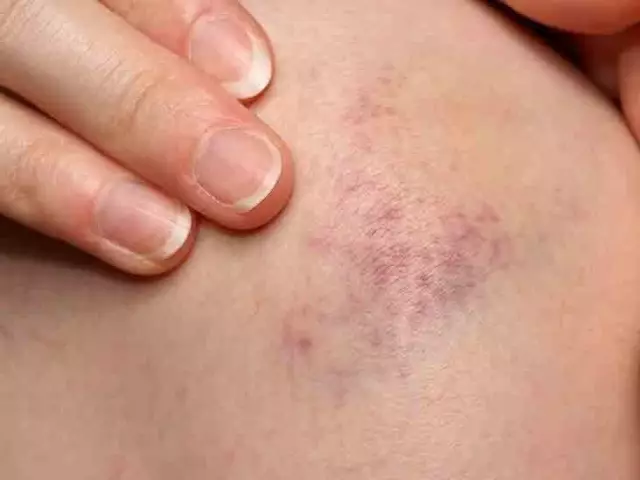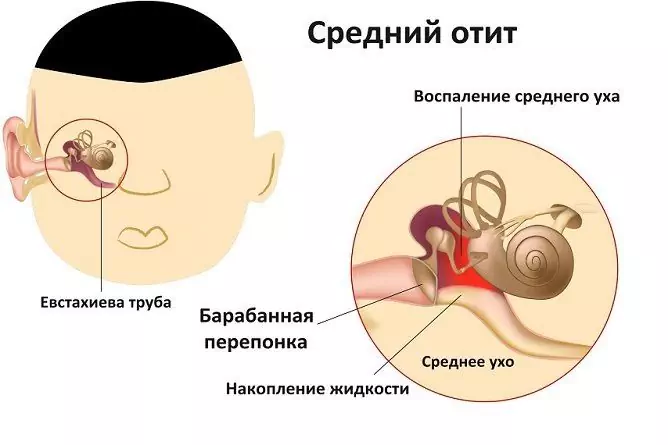- Author Rachel Wainwright [email protected].
- Public 2023-12-15 07:39.
- Last modified 2025-11-02 20:14.
Otitis

Otitis media refers to inflammation of the middle ear behind the eardrum, which is a small cavity that separates the ear canal from the inner ear.
Otitis media is the most common cause of hearing loss (hearing loss). This disease affects people of all ages, but children are most susceptible to otitis media, due to the peculiarities of the anatomical structure of the Eustachian tube - the cavity that connects the ear and the nasopharynx.
Otitis media
The two main causes of otitis media are infection and spread of inflammation from the nasopharynx to the middle ear, as well as ear trauma.
In acute respiratory viral diseases, an infection that affects the nasal mucosa enters the middle ear through the Eustachian (auditory) tube. Predisposing factors for the development of otitis media are swelling of the nasal mucosa, which interferes with the drainage of the middle ear cavity, as well as strong blowing of the nose simultaneously with both nostrils. Chronic diseases of the ENT organs (sinusitis, tonsillitis, etc.) can also cause otitis media, since the ears, nose and throat are interconnected. Infection from other organs, carried through the bloodstream, can also cause otitis media.
Otitis media injuries to the middle ear can be with or without penetration. Penetrating injuries occur when the integrity of the tympanic membrane is violated by a foreign object. Non-penetrating injuries occur when there is a sharp drop in atmospheric pressure, for example, in an airplane (aerootitis) or underwater diving (mareotitis).
Otitis symptoms
Distinguish between acute and chronic otitis media. Acute otitis media, in turn, can be catarrhal (simple) or purulent. The symptoms of otitis media are similar for all forms of the disease, but their intensity and some features depend on the species.
The main symptom of acute otitis media is severe ear pain, which patients describe as twitching or shooting. Pain in acute otitis media can be very intense, intensifying in the evening. One of the symptoms of otitis media is the so-called autophony - the presence of constant noise in the ear that is not associated with sounds from the outside, ear congestion appears. Slight hearing loss possible. Acute otitis media is often accompanied by a rise in temperature, general malaise.
Acute purulent otitis media is even more difficult. Symptoms of otitis media in a purulent form are the same, but they appear more sharply. Dizziness may appear. With purulent otitis media, pus accumulates in the middle ear cavity, which breaks the eardrum and pours out through the ear canal. Oddly enough, suppuration serves as a favorable symptom of otitis media, since otherwise, pus can break through from the other side and pour out into the cranial space, which is an extremely negative complication of purulent otitis media and a life-threatening condition.
The symptoms of chronic otitis media are similar, but less pronounced. As a rule, there is pain, hearing loss is more significant than with acute otitis media. The symptom of autophony persists, there is a feeling of fullness, or congestion of the ear, as with water. Chronic suppurative otitis media is manifested by periodic suppuration from the external auditory canal. Significant hearing loss develops, the eardrum is perforated.
Children's diseases of otitis media, especially of a small child, may not be recognized for a long time, since the baby cannot explain the cause of the pain. Otitis media in a child manifests itself with general symptoms of ill health: crying, fever, sleep disturbances, refusal to eat. Since the pain in otitis media is shooting, crying can begin abruptly, at the time of the lumbago. In order to check whether a child has otitis media, you need to press your finger on the tragus, or with your palm on the entire auricle, creating a pressure drop. A sharp painful reaction will confirm the presence of otitis media in the child.
Children are characterized by acute otitis media, with a violent course. Otitis media in a child requires urgent medical intervention, since due to the structural features, an infection from the middle ear easily spreads to the meningeal membranes and into the cranial cavity, causing meningitis, encephalitis, and brain abscesses. These complications are life threatening.
Diagnosis of otitis media
The diagnosis is made on the basis of the characteristic symptoms of otitis media, patient complaints, as well as an otoscopy (examination of the lumen of the ear canal using a head reflector). Further diagnostic studies are carried out to clarify the form of the disease and determine the presence of complications. If a perforation of the tympanic membrane and the presence of purulent contents are detected, especially in chronic purulent otitis media, the contents are taken for bacteriological analysis in the laboratory. Audiometry is performed to determine hearing loss.
If you suspect a complication of otitis media or a tumor of the middle ear, a computed tomography or magnetic resonance imaging of the skull is performed.
Otitis media treatment
Treatment of otitis media should be immediate, due to the risk of developing severe complications: the spread of the disease into the space of the skull or into the inner ear (labyrinthitis), which can threaten complete hearing loss. Treatment of otitis media is conservative, consists of general and local therapy, but, if necessary, it can be supplemented with surgery.
If the cause of otitis media was a respiratory infection that got into the ear from the nasopharynx, then otitis media must be treated in combination with the treatment of the nasopharynx.
As a general treatment for otitis media, antibacterial, anti-inflammatory drugs, as well as drugs that stimulate immunity are used.
Local treatment of otitis media depends on its form.
In acute otitis media in catarrhal form, dry heat is prescribed to the ear area, in the form of compresses from woolen fabric, and the drainage of the Eustachian tube must be restored by instilling vasoconstrictor drops into the nose (Galazolin, Nazivin, Naphtizin, etc.) Anti-inflammatory and analgesic drops (Sofradex, etc.) are also instilled into the ear, a compress according to Tsitovich is applied: a cotton turunda is soaked in 3% alcoholic solution of boric acid and glycerin, injected into the external auditory canal and left for 3-4 hours, closing the ear canal with a cotton swab.

Acute purulent otitis media requires the use of antibiotic therapy, as well as the evacuation of pus from the middle ear cavity. In case of purulent otitis media in the acute stage, it is strictly forbidden to warm up the ear, and it is also not necessary to use ear drops and turundas. Local treatment of otitis media in a purulent form, namely, washing the middle ear with antiseptic solutions, is carried out by an ENT doctor or the patient himself after training.
Treatment of chronic otitis media also consists of anti-inflammatory and antibacterial therapy, with enhanced immunocorrection. Also, chronic otitis media and acute otitis media in the stage of subsiding of acute symptoms are successfully treated with physiotherapy methods (UHF, UV radiation, laser therapy, magnetotherapy).
Of the surgical methods for treating otitis media, the most often used is bypassing the tympanic membrane or paracentesis - an incision of the tympanic membrane in order to create an outflow of purulent contents.
YouTube video related to the article:
The information is generalized and provided for informational purposes only. At the first sign of illness, see your doctor. Self-medication is hazardous to health!






